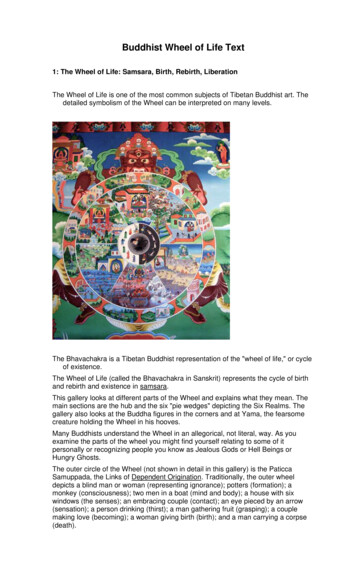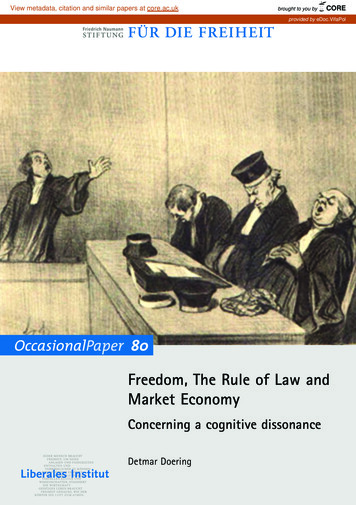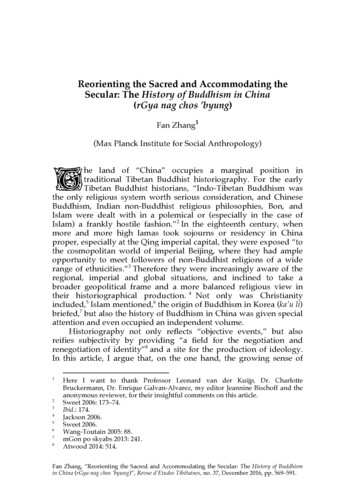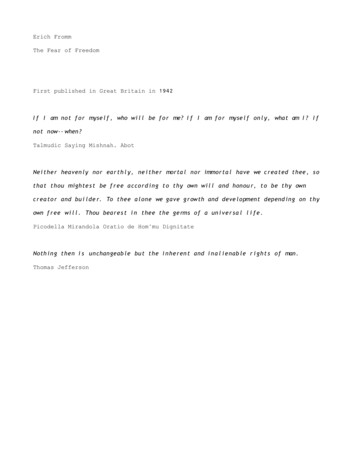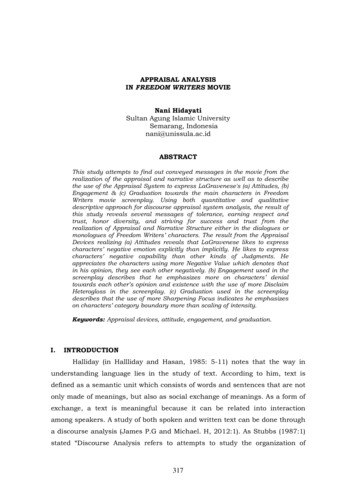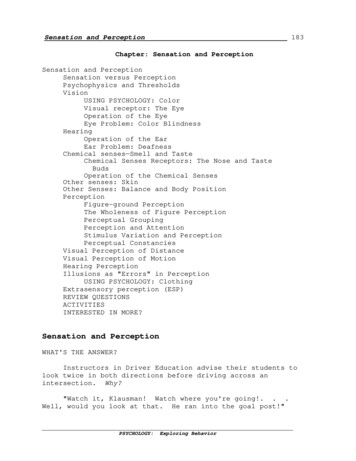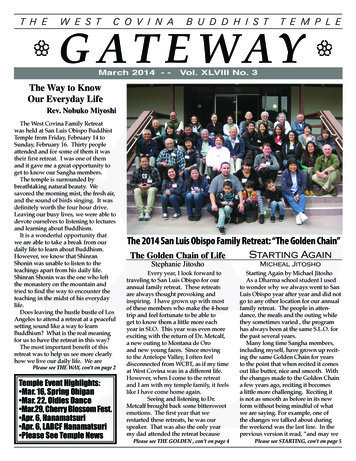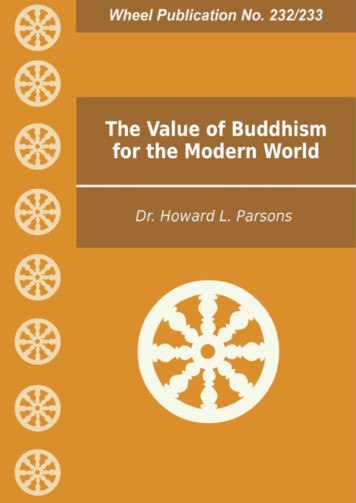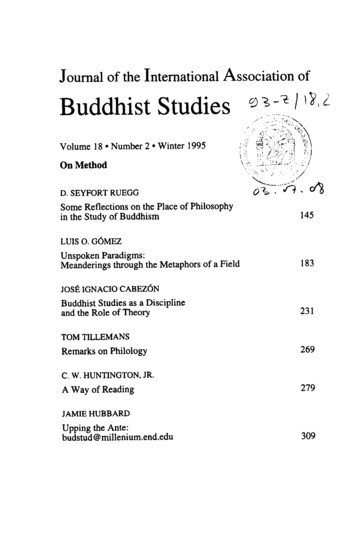
Transcription
A Taste of FreedomVen. Ajahn Chah(Phra Bodhiñáóa TheraThe Wheel Publication No. 357-359371
A Taste of FreedomSelected Dhamma TalksbyVenerable Ajahn Chah(Phra Bodhinyána Thera)
Buddhist Publication SocietyP.O. Box 61 54 Sangharaja MawathaKandy Sri Lankahttp://www.bps.lkCopyright 1980 & 1991, The Sangha, Bung Wai Forest MonasteryPublished with the kind permission of the Abbot, Wat PahNanachat, Ampher Warin, Ubon Rajathani, Thailand.1st BPS edition—19882nd BPS edition (revised)—2006, 2014National Library of Sri LankaCataloguing in Publication DataAjahn Chah himiTaste of Freedom: Selected Dhamma Talks / Ajahn Chahhimi.- Kandy: Buddhist Publication Society Inc., 2014BP525 - 106p.; 12.5cm.ISBN 978-955-24-0033-9i. 294.34 DDC 231. Buddhism - Doctrines and PracticeISBN 978-955-24-0033-9Typeset at BPS in Palatino BPS fontPrinted bySamayawardana Printers,Colombo 10.
ContentsIntroductionviiAbout this mind On Meditation12The Path in Harmony9The Benefits and Dangers of SamádhiThe Middle Way WithinThe Peace Beyond1727Opening the Dhamma Eye41Convention and Liberation61No Abiding70Right View—The Place of CoolnessEpilogue137985Occasion of the talks88About the Author—89A Biographical Sketch of Venerable Ajahn ChahNotes9389
Venerable Ajahn Chah
IntroductionThe talks translated in this book were all taken from oldcassette tape recordings of Venerable Ajahn Chah, some inThai and some in the northeastern Lao dialect. Most wererecorded on poor quality equipment under less thanoptimum conditions. This presented some difficulty in thework of translation, which was overcome by occasionallyomitting very unclear passages and at other times askingfor advice from other listeners more familiar with thoselanguages. Nevertheless, there has inevitably been someediting in the process of making this book. Apart from thedifficulties presented by the lack of clarity of the tapes,there is also the necessity of editing when one is takingwords from the spoken to the written medium. For this, thetranslator takes full responsibility.Pali words have occasionally been left as they are, inother cases translated. The criterion here has beenreadability. Those Pali words which were considered shortenough or familiar enough to the reader already conversantwith Buddhist terminology have generally been leftuntranslated. This should present no difficulty, as they aregenerally explained by the Venerable Ajahn in the course ofthe talk. Longer words, or words considered to be probablyunfamiliar to the average reader, have been translated. Ofthese, there are two which are particularly noteworthy.They are kámasukhallikánuyogo and attakilamathánuyogo,vii
viii A Taste of Freedomwhich have been translated as “indulgence in pleasure”and “indulgence in pain” respectively. These two wordsoccur in no less than five of the talks included in this book,and, although the translations provided here are not thosegenerally used for these words, they are, nevertheless, inkeeping with the Venerable Ajahn’s use of them.Venerable Ajahn Chah always gave his talks in simple,everyday language. His objective was to clarify theDhamma, not to confuse his listeners with an overload ofinformation. Consequently, the talks presented here havebeen rendered into correspondingly simple English. Theaim has been to present Ajahn Chah’s teaching in both thespirit and the letter.In this edition of A Taste of Freedom, a number ofcorrections have been made to clumsily worded passages,of which there are now hopefully less than in the firstedition. For such inadequacies, the translator must alsotake responsibility and hopes the reader will bear withany literary shortcomings in order to receive the fullbenefit of the teachings contained herein.The translator
About this mind About this mind In truth there is nothing really wrongwith it. It is intrinsically pure. Within itself it's alreadypeaceful. That the mind is not peaceful these days isbecause it follows moods. The real mind doesn't haveanything to it, it is simply (an aspect of) Nature. It becomespeaceful or agitated because moods deceive it. Theuntrained mind is stupid. Sense impressions come and trickit into happiness, suffering, gladness and sorrow, but themind's true nature is none of those things. That gladness orsadness is not the mind, but only a mood coming to deceiveus. The untrained mind gets lost and follows these things, itforgets itself. Then we think that it is we who are upset or atease or whatever.However, really this mind of ours is already unmovingand peaceful Really peaceful! Just like a leaf which is stillas long as no wind blows. If a wind comes up, the leafflutters. The fluttering is due to the wind—the "fluttering"is due to those sense impressions; the mind follows them. Ifit doesn't follow them, it doesn't "flutter." If we know fullythe true nature of sense impressions, we will be unmoved.Our practice is simply to see the Original Mind. So we musttrain the mind to know those sense impressions, and notget lost in them. To make the mind peaceful—just this is theaim of all this difficult practice we put ourselves through.1
On MeditationTo calm the mind means to find the right balance. If youtry to force your mind too much, it goes too far. If youdon’t try enough, it doesn’t get there; it misses the point ofbalance.Normally, the mind isn’t still, it’s moving all the time,and it lacks strength. Making the mind strong and makingthe body strong are not the same. To make the body strongwe have to exercise it, to push it, in order to make itstrong, but to make the mind strong means to make itpeaceful, not to go thinking of this and that. For most of usthe mind has never been peaceful, it has never had theenergy of samádhi.If we force our breath to be too long or too short, we’renot balanced; the mind won’t become peaceful. It’s likewhen we first start to use a pedal sewing machine. At firstwe just practise pedalling the machine to get ourcoordination right, before we actually sew anything.Following the breath is similar. We don’t get concernedover how long or short, weak or strong it is—we just noteit. We simply let it be, following the natural breathing.When it’s balanced, we take the breathing as ourmeditation object. When we breathe in, the beginning ofthe breath is at the nose tip, the middle of the breath at thechest, and the end of the breath at the abdomen. This is thepath of the breath. When we breathe out, the beginning of2
On Meditation3the breath is at the abdomen, the middle at the chest andthe end at the nose tip. We simply take note of this path ofthe breath at the nose tip, the chest, and the abdomen, thenat the abdomen, the chest, and the tip of the nose. We takenote of these three points in order to make the mind firm, tolimit mental activity so that mindfulness and selfawareness can easily arise.When we are adept at noting these three points, we canlet them go and note the in and out breathing,concentrating solely at the tip of the nose or the upper lipwhere the air passes in and out. We don’t have to follow thebreath, we just establish mindfulness in front of us at thenose-tip and note the breath at this one point—entering,leaving, entering, leaving. There’s no need to think ofanything special, just concentrate on this simple task fornow, having continuous presence of mind. There’s nothingmore to do, just breathe in and out.Soon the mind becomes peaceful, the breath refined.The mind and body become light. This is the right state forthe work of meditation.When sitting in meditation, the mind becomes refined,but whatever the state is that it is in, we should try to beaware of it, to know it. Mental activity is there together withtranquility. There is vitakka, the action of bringing the mindto the theme of contemplation. If there is not muchmindfulness, there will be not much vitakka. Then vicára, thecontemplation around that theme, follows. Various “weak”mental impressions may arise from time to time, but ourself-awareness is the important thing—whatever may behappening we know it continuously. As we go deeper, we
4A Taste of Freedomare constantly aware of the state of our meditation,knowing whether or not the mind is firmly established.Thus, both concentration and awareness are present.To have a peaceful mind does not mean that there’snothing happening—mental impressions do arise. Forinstance, when we talk about the first level of absorption,we say it has five factors. Along with vitakka and vicára,pìti (rapture) arises with the theme of contemplation andthen sukha (happiness). These four things all lie together inthe mind established in tranquility. They are one state.The fifth factor is ekaggatá or one-pointedness. Youmay wonder how there can be one-pointedness whenthere are all these other factors as well. This is becausethey all become unified on that foundation of tranquility.Together they are called a state of samádhi. They are noteveryday states of mind; they are factors of absorption.There are these five characteristics, but they do not disturbthe basic tranquility. There is vitakka, but it does notdisturb the mind; vicára, rapture, and happiness arise, butdo not disturb the mind. The mind is, therefore, one withthese factors. The first level of absorption is like this.We don’t have to call it “first jhána”, “second jhána”,“third jhána”,1 and so on, let’s just call it “a peacefulmind.” As the mind becomes progressively calmer, it willdispense with vitakka and vicára, leaving only rapture andhappiness. Why does the mind discard vitakka and vicára?This is because, as the mind becomes more refined, theactivity of vitakka and vicára is too coarse to remain. At thisstage, as the mind leaves off vitakka and vicára, feelings ofgreat rapture can arise, tears may gush out. However, as
On Meditation5the samádhi deepens, rapture, too, is discarded, leavingonly happiness and one-pointedness, until finally evenhappiness goes, and the mind reaches its greatestrefinement. There is only equanimity and onepointedness—all else has been left behind. The mind standsunmoving.Samádhi is the state of concentrated calm resultingfrom meditation practice. Once the mind is peaceful, thiscan happen. You don’t have to think a lot about it, it justhappens by itself. This is called the energy of a peacefulmind. In this state the mind is not drowsy; the fivehindrances—sense desire, aversion, restlessness, dullness,and doubt—have all fled.However, if mental energy is still not strong andmindfulness is weak, there will occasionally arise intrudingmental impressions. The mind is peaceful, but it’s as if thereis “cloudiness” within the calm. It’s not a normal sort ofdrowsiness though, some impressions will manifest—maybe we’ll hear a sound or see a dog or something. It’s notreally clear, but it’s not a dream either. This is because thesefive factors have become unbalanced and weak.The mind tends to play tricks within these levels oftranquility. Visions will sometimes arise through any of thesenses when the mind is in this state, and the meditatormay not be able to tell exactly what is happening. “Am Isleeping? No. Is it a dream? No, it’s not a dream ” Theseimpressions arise from a middling sort of tranquility; but ifthe mind is truly calm and clear, we don’t doubt thevarious mental impressions or visions which arise.Questions like, “Did I drift off then? Was I sleeping? Did I
6A Taste of Freedomget lost?” don’t arise, for they are characteristics of a mindwhich is still doubting. “Am I asleep or awake? ” thusthe mind is fuzzy. This is the mind getting lost in itsmoods. It’s like the moon going behind a cloud. You canstill see the moon, but the clouds covering it render ithazy. It’s not like the moon that has emerged from behindthe clouds—clear, sharp and bright.When the mind is peaceful and established firmly inmindfulness and self-awareness, there will be no doubtconcerning the various phenomena which we encounter.The mind will truly be beyond the hindrances. We willclearly know as it is everything which arises in the mind.We do not doubt it because the mind is clear and bright.The mind which reaches samádhi is like this.However, some people find it hard to enter samádhibecause it doesn’t suit their tendencies. There is samádhi,but it’s not strong or firm. However, one can attain peacethrough the use of wisdom, through contemplating andseeing the truth of things, solving problems that way. Thisis using wisdom rather than the power of samádhi. Toattain calm in practice it’s not necessary to sit inmeditation, for instance. Just ask yourself, “Eh, what isthat?” and solve your problem right there! A person withwisdom is like this. Perhaps he can’t really attain highlevels of samádhi, although he develops some, enough tocultivate wisdom. It’s like the difference between farmingrice and farming corn. One can depend on rice more thanon corn for one’s livelihood. Our practice can be like this,we depend more on wisdom to solve problems. When wesee the truth, peace arises.
On Meditation7The two ways are not the same. Some people haveinsight and are strong in wisdom, but do not have muchsamádhi. When they sit in meditation, they aren’t verypeaceful. They tend to think a lot, contemplating this andthat, until eventually they contemplate happiness andsuffering and see the truth of them. Some incline moretowards this than samádhi. Whether standing, walking,sitting, or lying,3 the realisation of the Dhamma can takeplace. Through seeing, through relinquishing, they attainpeace. They attain peace through knowing the truthwithout doubt, because they have seen it for themselves.Other people have only a little wisdom, but theirsamádhi is very strong. They can enter very deep samádhiquickly, but not having much wisdom, they cannot catchtheir defilements, they don’t know them. They can’t solvetheir problems.However, regardless of whichever approach we use,we must do away with wrong thinking, leaving only RightView. We must get rid of confusion, leaving only peace.Either way, we end up at the same place. There are thesetwo sides to practice, but these two things, calm andinsight, do go together. We can’t do away with either ofthem. They must go together.That which “looks over” the various factors which arisein meditation is sati, mindfulness. This sati is a conditionwhich, through practice, can help other factors to arise. Satiis life. Whenever we don’t have sati, when we are heedless,it’s as if we are dead. If we have no sati, then our speechand actions have no meaning. This sati is simplyrecollection. It’s a cause for the arising of self-awareness
8A Taste of Freedomand wisdom. Whatever virtues we have cultivated areimperfect if lacking in sati. Sati is that which watches overus while standing, walking, sitting, and lying. Even whenwe are no longer in samádhi, sati should be presentthroughout.Whatever we do, we do carefully. A sense of shame4will arise. We will feel ashamed about the things we dowhich aren’t correct. As shame increases, our composurewill increase as well. When composure increases,heedlessness will disappear. Even if we don’t sit inmeditation, these factors will be present in the mind.These factors arise because of cultivating sati. Developsati! This is the quality (dhamma) which looks over thework we are doing or have done in the past. It has realvalue. We should know ourselves at all times. If we knowourselves like this, right will distinguish itself fromwrong, the path will become clear, and the cause for allshame will dissolve. Wisdom will arise. We can unify thepractice as morality, concentration, and wisdom. To becollected, to be controlled, this is morality. The firmestablishing of the mind within that control isconcentration. Complete, overall knowledge within theactivity in which we are engaged is wisdom. In brief, thepractice is just morality, concentration and wisdom, or inother words, the path. There is no other way.
The Path in HarmonyToday I would like to ask you all, “Are you sure yet, are youcertain in your meditation practice?” I ask, because thesedays there are many people teaching meditation, bothmonks and laypeople, and I’m afraid you may be subject towavering and doubt. Only if we understand clearly, we willbe able to make the mind peaceful and firm.You should understand “the Eightfold Path” asmorality, concentration and wisdom. The path comestogether as simply as this. Our practice is to make this patharise within us.When sitting in meditation, we are told to close theeyes, not to look at anything else, because now we aregoing to look directly at the mind. When we close our eyes,our attention comes inwards. We establish our attention onthe breath, centre our feelings there, and put ourmindfulness there. When the factors of the path are inharmony, we will be able to see the breath, the feelings, themind, and its mood for what they are. Here we will see the“focus point,” where samádhi and the other factors of thepath converge in harmony.When you are sitting in meditation, following thebreath, think to yourself that you are sitting alone. There isno one sitting around you, there is nothing at all. Developthis feeling that you are sitting alone until the mind lets goof all externals, concentrating solely on the breath. If you9
10A Taste of Freedomare thinking, “This person is sitting over here, that personis sitting over there,” there is no peace and the minddoesn’t come inwards. Just cast all that aside until you feelthere is no one sitting around you, until there is nothing atall, until you have no interest in your surroundings and nowavering.Let the breath go naturally; don’t force it to be short orlong or whatever. Just sit and watch it going in and out.When the mind lets go of all external impressions, thesounds of cars and so on will not disturb you. Nothing,whether sights or sounds, will disturb you, because themind doesn’t receive them. Your attention will cometogether on the breath.If the mind is confused and won’t concentrate on thebreath, take a full, deep breath, as deep as you can, andthen let it all out till there is none left. Do this three timesand then re-establish your attention. The mind willbecome calm.It’s natural for the mind to be calm for a while, andthen restlessness and confusion may arise again. Whenthis happens, concentrate, breathe deeply again, and thenreestablish your attention on the breath. Just keep goinglike this. When this has happened many times you willbecome adept at it, the mind will let go of all externalimpressions and they will not reach the mind. Sati will befirmly established. As the mind becomes more refined, sodoes the breath. Feelings will become finer and finer, thebody and mind will be light. Our attention is solely on theinner—we see the in-breaths and out-breaths clearly, andwe see all impressions clearly. We will see the coming
The Path in Harmony11together of morality, concentration and wisdom. This iscalled the path in harmony. When there is this harmony,the mind will be free of confusion, it will come together asone. This is known as samádhi.After watching the breath for a long time, it maybecome very refined; the awareness of the breath willgradually cease, leaving only bare awareness. The breathmay become so refined it disappears! Perhaps we are “justsitting,” as if there is no breathing at all. Actually, there isbreathing, but it seems as if there’s none. This is because themind has reached its most refined state, there is just bareawareness. It has gone beyond the breath. The knowledgethat the breath has disappeared becomes established. Whatwill we take as our object of meditation now? We take justthis knowledge as our object, that is, the awareness thatthere’s no breath.Unexpected things may happen at this time; somepeople experience them, some don’t. If they do arise, weshould be firm and have strong mindfulness. Some peoplenotice that the breath has disappeared and get fear; they’reafraid they might die. Here we should know the situationjust as it is. We simply notice that there’s no breath and takethat as our object of awareness. This, we can say, is thefirmest, surest type of samádhi. There is only one firm,unmoving state of mind. Perhaps the body will become solight it’s as if there is no body at all. We feel like we’resitting in empty space, everything seems empty. Althoughthis may seem very unusual, you should understand thatthere’s nothing to worry about. Firmly establish your mindlike this.
12A Taste of FreedomWhen the mind is firmly unified, having no senseimpressions to disturb it, one can remain in that state forany length of time. There will be no painful feelings todisturb us. When samádhi has reached this level, we canleave it when we choose, but if we come out of thissamádhi, we do so comfortably, not because we’vebecome bored with it or tired. We come out because we’vehad enough for now; we feel at ease, we have no problemsat all.If we can develop this type of samádhi, then, if we sit,say, thirty minutes or an hour, the mind will be cool andcalm for many days. When the mind is cool and calm likethis, it is clean. Whatever we experience, the mind willtake it up and investigate it. This is a fruit of samádhi.Morality has one function. Concentration has anotherfunction, and Wisdom another. These factors are like acycle. We can see them all within the peaceful mind. Whenthe mind is calm, it has collectedness and restraint becauseof wisdom and the energy of concentration. As it becomesmore collected, it becomes more refined, which in turngives morality the strength to increase in purity. As ourmorality becomes purer, it will help in the development ofconcentration. When concentration is firmly established, ithelps in the arising of wisdom. Morality, concentration,and wisdom help each other, they are interrelated likethis. In the end, the path becomes one and functions at alltimes. We should look after the strength which arises fromthe path, because it is the strength which leads to Insightand Wisdom.
The Benefits and Dangers OfSamádhiSamádhi is capable of bringing much harm or much benefitto the meditator; you can’t say it brings only one or theother. For one who has no wisdom it can be harmful, butfor one who has wisdom it can bring real benefit, it can leadhim to Insight.That which can be most harmful to the meditator isabsorption—samádhi, jhána, the samádhi with deep,sustained calm. This samádhi brings great peace. Whenthere is peace, there is happiness. When there is happiness,attachment and clinging to that happiness arise. Themeditator doesn’t want to contemplate anything else; hejust wants to indulge in that pleasant feeling. When wehave been practising for a long time, we may become adeptat entering this samádhi very quickly. As soon as we startto note our meditation object, the mind enters calm, and wedon’t want to come out to investigate anything. We just getstuck on that happiness. This is a danger for one who ispractising meditation.We must make use of upacára-samádhi. Here, we entercalm, and then, when the mind is sufficiently calm, wecome out and look at outer activity.5 Looking at the outsidewith a calm mind gives rise to wisdom. This is hard tounderstand, because it’s almost like ordinary thought and13
14A Taste of Freedomimagining. When thought is there, we may assume thatthe mind isn’t peaceful, but actually that thought is takingplace within the calm. There is contemplation, but itdoesn’t disturb the calm. We may bring thought up inorder to contemplate it, to investigate it; it’s not that weare aimlessly thinking or guessing away—it’s somethingthat arises from a peaceful mind. This is called “awarenesswithin calm, and calm within awareness.” If it’s simplyordinary thought and imagination, the mind won’t bepeaceful, it will be disturbed. However, I am not talkingabout ordinary thought; this is a feeling that arises fromthe peaceful mind. It’s called “contemplation.” Wisdom isborn right here.So, there can be right samádhi and wrong samádhi.Wrong samádhi is where the mind enters calm and there’sno awareness at all. One could sit for two hours or even allday, but the mind doesn’t know where it’s been or what’shappened. It doesn’t know anything. There is calm, butthat’s all. It’s like a well-sharpened knife which we don’tbother to put to any use. This is a deluded type of calm,because there is not much self-awareness. The meditatormay think he has reached the ultimate already, so hedoesn’t bother to look for anything else. Samádhi can bean enemy at this level. Wisdom cannot arise because thereis no awareness of right and wrong.With right samádhi, no matter what level of calm isreached, there is awareness. There is full mindfulness andclear comprehension. This is the samádhi which can giverise to wisdom, one cannot get lost in it. Practitionersshould understand this well. You can’t do without this
The Benefits and Dangers Of Samádhi15awareness; it must be present from beginning to end. Thiskind of samádhi has no danger.You may wonder, “When does the benefit arise? Howdoes the wisdom arise? From samádhi?” When rightsamádhi has been developed, wisdom has the chance toarise at all times. When the eye sees form, the ear hearssound, the nose smells odor, the tongue experiences taste,the body experiences touch, or the mind experiencesmental impressions—in all postures—the mind stays withfull knowledge of the true nature of those senseimpressions, it doesn’t “pick and choose.” In any posture,we are fully aware of the birth of happiness andunhappiness. We let go of both of these things, we don’tcling. This is called Right Practice, which is present in allpostures. These words, “all postures,” do not refer only tobodily postures, they refer to the mind, which hasmindfulness and clear comprehension of the truth at alltimes. When samádhi has been rightly developed, wisdomarises like this. This is called “insight,” knowledge of thetruth.There are two kinds of peace—the coarse and therefined. The peace which comes from samádhi is the coarsetype. When the mind is peaceful there is happiness. Themind then takes this happiness to be peace. However,happiness and unhappiness are becoming and birth. Thereis no escape from saísára6 here because we still cling tothem. So happiness is not peace, peace is not happiness.The other type of peace is that which comes fromwisdom. Here we don’t confuse peace with happiness; weknow the mind which contemplates and knows happiness
16A Taste of Freedomand unhappiness as peace. The peace which arises fromwisdom is not happiness, but is that which sees the truthof both happiness and unhappiness. Clinging to thosestates does not arise, the mind rises above them. This isthe true goal of all Buddhist practice.
The Middle Way WithinThe teaching of Buddhism is about giving up evil andpractising good. Then, when evil is given up and goodnessis established, we must let go of both good and evil. Wehave already heard enough about wholesome andunwholesome conditions to understand something aboutthem, so I would like to talk about the Middle Way, that is,the path to escape from both of those things.All the Dhamma talks and teachings of the Buddhahave one aim—to show the way out of suffering to thosewho have not yet escaped. The teachings are for thepurpose of giving us the right understanding. If we don’tunderstand rightly, then we can’t arrive at peace.When the various Buddhas became enlightened andgave their first teachings, they all declared these twoextremes—indulgence in pleasure and indulgence in pain.7These two ways are the ways of infatuation; they are theways between which those who indulge in sense pleasuresmust fluctuate, never arriving at peace. They are the pathswhich keep us spinning around in saísára.The Enlightened One observed that all beings are stuckin these two extremes, never seeing the Middle Way ofDhamma, so he pointed them out in order to show thepenalty involved in both. Because we are still stuck,because we are still wanting, we live repeatedly under theirsway. The Buddha declared that these two ways are the17
18A Taste of Freedomways of intoxication; they are not the ways of a meditator,nor the ways to peace. These ways are indulgence inpleasure and indulgence in pain, or, to put it simply, theway of slackness and the way of tension. If you investigatewithin, moment by moment, you will see that the tenseway is anger, the way of sorrow. Going this way, there isonly difficulty and distress. indulgence in pleasure—ifyou’ve escaped from this, it means you’ve escaped fromhappiness. These ways, both happiness and unhappiness,are not peaceful states. The Buddha taught to let go ofboth of them. This is right practice. This is the MiddleWay.These words, “the Middle Way,” do not refer to ourbody and speech, they refer to the mind. When a mentalimpression which we don’t like arises, it affects the mindand there is confusion. When the mind is confused, whenit’s “shaken up,” this is not the right way. When a mentalimpression arises which we like, the mind goes toindulgence in pleasure—that’s not the way either.We people don’t want suffering, we want happiness.However, in fact, happiness is just a refined form ofsuffering. Suffering itself is the coarse form. You cancompare them to a snake. The head of the snake isunhappiness; the tail of the snake is happiness. The headof the snake is really dangerous, it has the poisonousfangs. If you touch it, the snake will bite straight away.However, never mind the head, even if you go and holdonto the tail, it will turn around and bite you just thesame, because both the head and the tail belong to the onesnake.
The Middle Way Within19In the same way, both happiness and unhappiness, orpleasure and sadness, arise from the same parent—wanting. So when you’re happy the mind isn’t peaceful. Itreally isn’t! For instance, when we get the things we like,such as wealth, pres
Venerable Ajahn Chah always gave his talks in simple, everyday language. His objective was to clarify the Dhamma, not to confuse his listeners with an overload of information. Consequently, the talks presented here have been rendered into correspondingly simple English. The aim has been to
